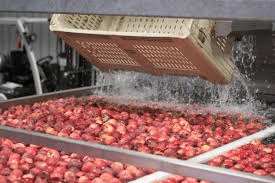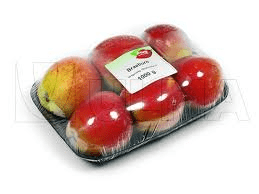To successfully export apples, start by selecting high-quality apples that are ripe, free from bruises, and disease-free. Wash the apples thoroughly to remove any dirt or pesticide residue, using food-grade cleaners if necessary.
Next, sort and grade the apples by size, color, and quality, ensuring only the best ones are selected for export. Inspect for any damage and remove unsuitable apples. After washing, ensure the apples are completely dry to prevent mold during transport.
Apply a food-safe protective coating to maintain freshness and appearance. Pack the apples in export-grade cartons or crates with cushioning materials to prevent bruising, and label each package with the contents, grade, and necessary export information.
Store the packed apples in a cool, dry place until they are ready for shipping. Finally, coordinate with shipping companies to arrange transport and ensure all export documents comply with the destination country’s requirements.
Choose sturdy cartons or crates designed for apple export. Use dividers and cushioning materials to prevent apples from touching each other and bruising. Ensure the packaging allows proper ventilation to prevent spoilage and is food-grade approved for fresh produce.
Pack apples by grade and size to meet buyer specifications and expectations. Clearly label each box with the variety, grade, size, weight, and other relevant information, including barcodes if required. Securely seal each box with strong tape or staples and inspect for proper sealing and labeling before shipping.
Store the packaged apples in a cool, dry place until ready for shipment. Coordinate with logistics companies to arrange transportation suitable for fresh produce.
Research potential export markets, considering factors like demand, competition, and import regulations. Ensure your apples meet export regulations of both your country and the destination country, including quality standards and phytosanitary requirements.
Obtain necessary certifications such as Global GAP or USDA Organic. Set a competitive price for your apples, taking into account production, shipping costs, and market prices. Establish relationships with reliable buyers through trade shows, online marketplaces, or export agencies.
Ensure proper packaging to maintain quality during transit. Work with experienced logistics providers for suitable shipping conditions and monitor the shipment to ensure timely and good condition arrival.
Use insurance to protect against risks like damage or loss during transit. Evaluate the process after each shipment and gather feedback to improve future shipments and increase profitability.
How to Process Apples for Exportation

1. Select High-Quality Apples: Choose apples that are ripe, free from bruises, and have no signs of disease. High-quality apples are essential for export.
2. Wash the Apples: Clean the apples thoroughly with water to remove any dirt or pesticide residue. Use food-grade cleaners if necessary.
3. Sort and Grade the Apples: Sort apples by size, color, and quality. Grading ensures that only the best apples are exported and helps in pricing.
4. Remove Damaged Apples: Inspect apples for any damage or imperfections. Remove any apples that are not suitable for export.
5. Dry the Apples: After washing, make sure the apples are completely dry. Excess moisture can lead to mold during transport.
6. Apply Protective Coating: Use a food-safe wax or coating to protect the apples during shipping. This helps in preserving freshness and appearance.
7. Pack the Apples: Place the apples in export-grade cartons or crates. Use cushioning materials to prevent bruising and ensure they are packed tightly to avoid movement.
8. Label the Packages: Clearly label each package with the contents, grade, and any necessary export information like origin and destination.
9. Store in a Cool Place: Keep the packed apples in a cool, dry place until they are ready for shipping. Temperature control is crucial to maintain freshness.
10. Prepare for Shipment: Coordinate with shipping companies to arrange for transport. Ensure that all export documents are ready and comply with the destination country’s requirements.
Read Also: Egg Processing and Storage Methods
How to Package Apples for Exportation

1. Choose the Right Packaging Material: Select sturdy cartons or crates specifically designed for apple export. They should be strong enough to protect the apples during transit.
2. Use Dividers and Cushioning: Place dividers inside the boxes to keep the apples from touching each other. Use cushioning materials like foam or paper to prevent bruising.
3. Ensure Proper Ventilation: Use boxes with ventilation holes to allow air circulation. Proper ventilation prevents apples from spoiling.
4. Check for Food-Grade Approval: Make sure all packaging materials are food-grade and approved for use with fresh produce. This ensures safety and compliance with regulations.
5. Pack Apples by Grade and Size: Pack apples according to their grade and size. This consistency helps in meeting buyer specifications and expectations.
6. Label Each Box: Clearly label each box with the variety of apples, grade, size, weight, and any other relevant information. Include barcodes if required.
7. Seal the Packages: Securely seal each box to protect the apples during transport. Use strong tape or staples to ensure the boxes remain closed.
8. Inspect the Packages: Before shipping, inspect each package to ensure it is properly sealed and labeled. Check for any signs of damage.
9. Store in a Cool Environment: Keep the packaged apples in a cool, dry storage area until they are ready for shipment. Proper storage helps maintain freshness.
10. Arrange Transportation: Coordinate with logistics companies to arrange transportation. Ensure that the transportation conditions are suitable for fresh produce.
How to Export Apples for Profits
1. Research Export Markets: Identify potential markets for your apples. Consider factors like demand, competition, and import regulations.
2. Comply with Export Regulations: Ensure that your apples meet the export regulations of both your country and the destination country. This includes quality standards and phytosanitary requirements.
3. Obtain Necessary Certifications: Obtain certifications such as Global GAP, USDA Organic, or others required by the destination market. These certifications can add value to your apples.
4. Price Competitively: Set a competitive price for your apples. Consider production costs, shipping costs, and market prices in the destination country.
5. Find Reliable Buyers: Establish relationships with reliable buyers in the destination country. This can be done through trade shows, online marketplaces, or export agencies.
6. Use Proper Packaging: Ensure that your apples are packaged correctly to maintain quality during transit. Proper packaging can prevent losses and increase customer satisfaction.
7. Arrange Logistics: Work with experienced logistics providers to arrange transportation. Ensure that the shipping conditions are suitable for fresh produce.
8. Monitor the Shipment: Track the shipment to ensure it reaches the destination on time and in good condition. Stay in contact with the logistics provider for updates.
9. Manage Risks: Use insurance to protect against potential risks like damage or loss during transit. This can safeguard your investment.
10. Evaluate and Improve: After each shipment, evaluate the process and gather feedback from buyers. Use this information to improve future shipments and increase profitability.
Read Also: Difference Between Poultry Vaccines and Poultry Drugs
Frequently Asked Questions (FAQs) About Apples

1. What is the best variety of apple for export?
Different markets prefer different varieties, but popular ones include Fuji, Gala, and Red Delicious due to their taste and durability.
2. How should apples be stored before export?
Apples should be stored in a cool, dry place with proper ventilation to maintain freshness.
3. What are the common diseases affecting apples?
Common diseases include apple scab, powdery mildew, and fire blight, which can affect the quality of apples.
4. How long do apples stay fresh during shipping?
With proper storage and packaging, apples can stay fresh for several weeks during shipping.
5. What certifications are required for exporting apples?
Certifications like Global GAP, USDA Organic, and others depending on the destination country’s requirements are often necessary.
6. How can I find buyers for my apples?
You can find buyers through trade shows, online marketplaces, export agencies, and by networking with importers in the destination country.
7. What is the importance of apple grading?
Grading ensures consistency in size, color, and quality, which helps in meeting buyer expectations and pricing.
8. How do I handle apple export documentation?
Work with export agencies or consultants to ensure all necessary documentation, like phytosanitary certificates and export permits, are in place.
9. What packaging materials are best for apple export?
Sturdy, food-grade cartons or crates with dividers and cushioning materials are best for protecting apples during transit.
10. Can I export organic apples?
Yes, but you need to obtain organic certifications and comply with the organic standards of the destination country.
Read Also: How to Grow Your Business
